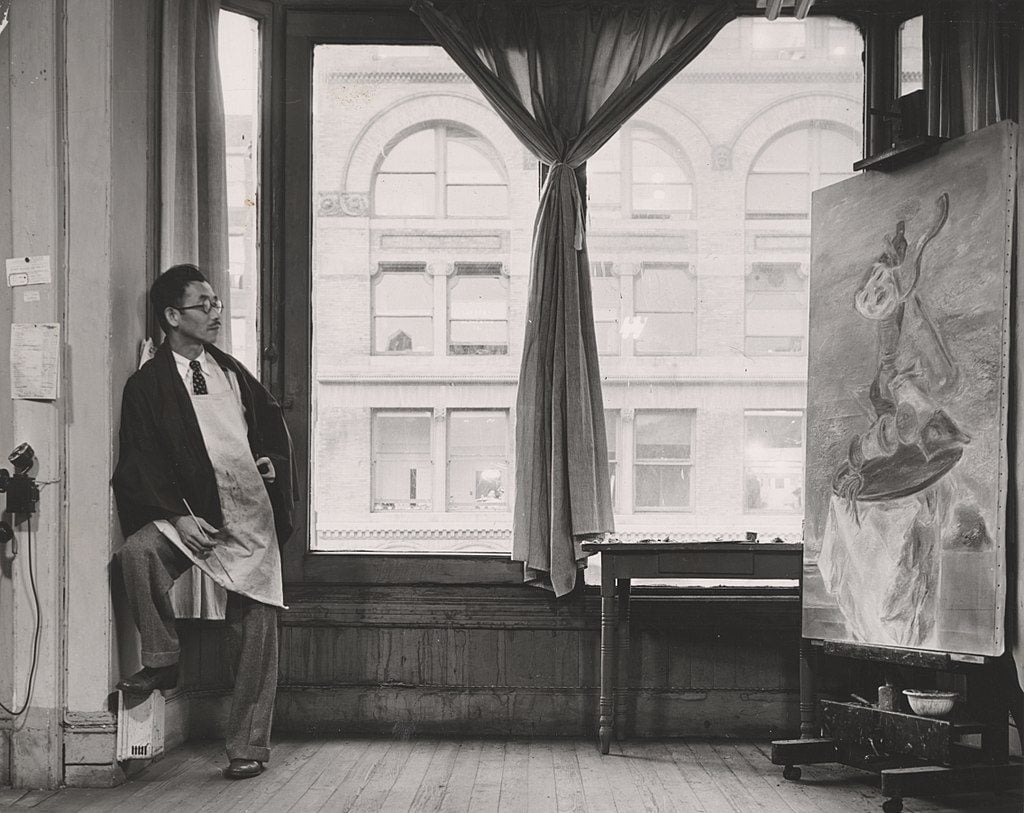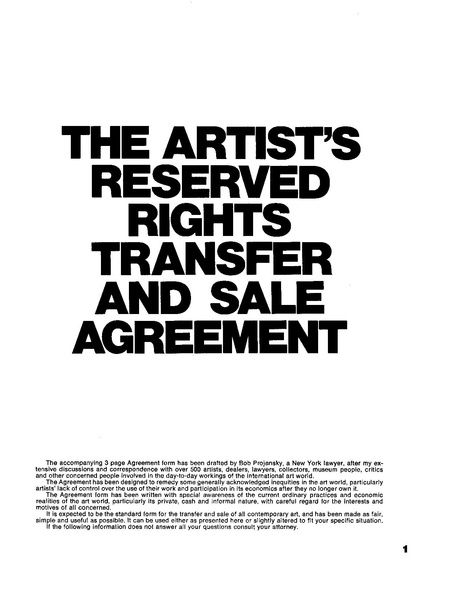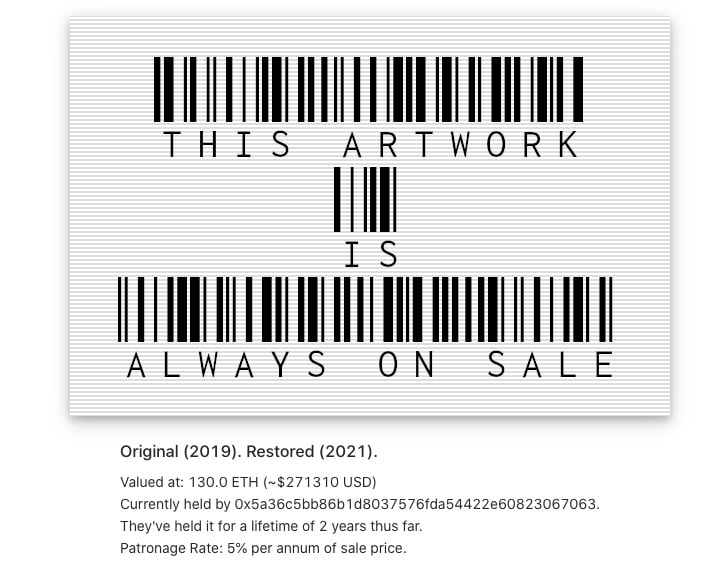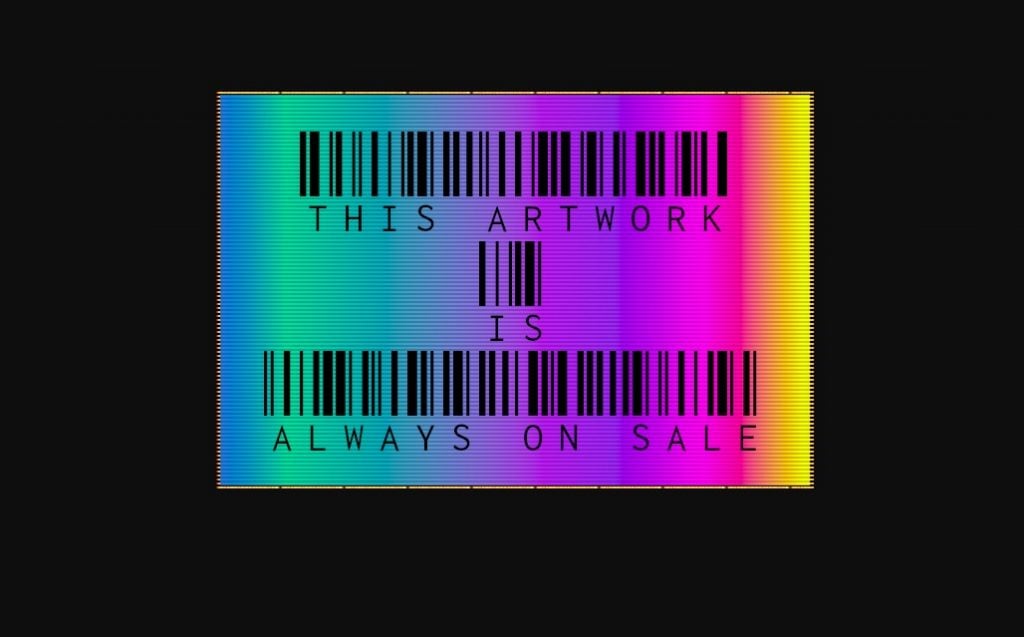Amid all the recent backlash against NFTs, the real and exciting possibilities that blockchain technology offers for solving longstanding flaws in the art market could be lost. The great promise of blockchain is something more than just letting people buy and sell digital art. This new technology holds the potential to give artists of all kinds equity in their work.
A smart contract is a code that executes a set of conditions required for a trade to occur; if one condition fails, then so does the trade. Thus, by adopting blockchain smart contracts to trade ownership of their work, an artist can ensure resale royalties as a condition for the transfer of title, meaning they automatically get a cut of any future sales of their work.
Indeed, it’s easily conceivable that with this technology, an artist could stipulate that her sale price compensate not only herself and the gallery, but gallery staff, studio assistants, or a non-profit, any or all of whom might continue to be compensated in future resales. Though such ideas are yet to be codified, the new interest in the technology has already made artist royalties a reality for contemporary creators in a newly tangible way—a dream of five generations of artist-activists who have fought to solve the problem of how to get a bigger share of the art market.
There is some outcry, now, that blockchain represents the final collapse of the art world into a hyper-commercial, speculative market. Yet if that happens, the industry has only itself to blame for ignoring design options within this developing space, as well as for refusing to support any of the many past social or legal proposals to uplift artists.
Early Efforts
As early as 1883, the artist Frank T. Robinson worked with the New England Manufacturers and Mechanics Institute to establish equity payments for artists in group shows, but most attempts to improve the lot of artists date back to the Depression era.
Many artists involved in the Works Progress Administration in the 1930s would go on to found Artists Equity Association in 1947, with the explicit mission “to address business and economic issues affecting American artists.” Yasuo Kuniyoshi, an artist who had produced anti-Axis imagery for the war effort but was nevertheless declared an “enemy alien” in 1941, was the organizing force and first president (1947–51).

Kuniyoshi working on his painting “Upside Down Table and Mask” in his studio near Union Square at 30 East Fourteenth Street in New York City. Photo by Max Yavno, courtesy the Archives of American Art.
Kuniyoshi worked strenuously to avoid political language like the word “union” at a time when the nation already interpreted socialist tendencies among artists as inherently un-American. He gathered an impressive roster of 160 established and emerging artists including Jacob Lawrence, Alice Neel, Louise Nevelson, Isamu Noguchi, David Smith, and Charles Sheeler as founding members. A select group developed the initial 15-point program, which included such wide-ranging concerns as an emergency welfare fund for artists, a group health insurance plan, artists’ rights surrounding televised work, museum board representation, the desire to cultivate state and federal art projects, rental fees for exhibited work, and more.
It was an impressive effort, but even famous members like Grace Hartigan, Frank Stella, and the de Koonings could not leverage their celebrity to get the rights the group sought. Internal disputes eventually led to a split within the AEA. Nevelson served as the last national president from 1963 to 1965. (New York’s Artists Equity Association now carries the mantle, offering workshops and a members’ gallery on the Lower East Side.)
In general, American artists still retain no control over how a work is used and gain no compensation for any increase in its value after it is first sold. France recognized a resale royalty all the way back in 1920, and most of Europe followed—but such measures have been repeatedly rejected within the United States. The Art Proceeds Act proposed in 1966 that artists retain a three percent royalty right on all resales. The same was suggested for the revisions to the Copyright Act of 1976. In neither instance did it succeed.
The Siegelaub-Projansky Agreement
In 1969, the Art Workers’ Coalition (AWC) formed after the artist Takis objected to the way his Tele-Sculpture (1960) was displayed at the Museum of Modern Art. Starting from this concern with artists’ lack of legal or political rights regarding exhibition practices, the AWC’s activism in the following years would eventually grow to target museum policies, artists’ financial rights, health insurance, racial equality, and more across several open hearings.
Among those intervening in these debates was the art dealer, collector, and writer Seth Siegelaub. Inspired by the foment around the AWC, he composed the Artist’s Reserved Rights Transfer and Sale Agreement with lawyer Robert M. Projansky. It was an effort to change industry practices through both social pressure and legal means, by setting up a system through which an artist got a cut of secondary market sales going forward.

First page of the Siegelaub-Projansky contract.
In 1971, Siegelaub reached out to more than 500 artists, collectors, critics, curators, dealers, and other art-market participants about how to develop an industry-wide agreement that addressed blatant inequities. As he wrote in the opening of the agreement, “The ills it remedies are universally acknowledged.”
The Siegelaub-Projansky Agreement aimed to reform industry norms using the existing market structures and common law practices. Printed in numerous magazines and journals between 1971 and 1973 and displayed at Documenta V in 1972, it is a record of how artists and their advocates processed a moment when equity was being pursued across so many areas of civil society.
Artists such as Hans Haacke still use this agreement, though only for works valued over $300. Others like Adrian Piper use variations on it. It was, in fact, designed to be flexible (with sections that artists could strike out) to make it easier to adopt.
For certain conceptual artists, the market orientation of the Siegelaub-Projansky Agreement was itself a problem. Critic and curator Lucy Lippard, artist Lawrence Weiner, and others who were committed to the values of conceptual art rejected the agreement because they believed it went against the anti-capitalist aims of dematerializing the art object.

Portrait of art collectors Robert and Ethel Scull as they pose with artists George Segal, Andy Warhol, and James Rosenquist, at the Scull’s home, November 1973. Photo by Jack Mitchell/Getty Images.
Still, as long as artists are in the market, it seems fair that they be in it proactively. In 1973, taxi magnate Robert Scull famously drew much scrutiny for a sale of contemporary artworks from his collection. Robert Rauschenberg’s Thaw, purchased from the artist for $900 in 1958, went for $85,000—a staggering run-up in value that was somewhat shocking at the time.
Even as taxi drivers were picketing Scull outside for shoddy treatment, Rauschenberg confronted his collector inside about flipping the artworks with no benefit to the artist. “I’ve been working my ass off for you to make that profit?” Raushenberg said to Scull in an uneasy exchange caught on camera after the sale. The confrontation has passed into legend partly because it reflects a widespread sense of grievance on the part of artists.
Enter Blockchain
The 1977 California Resale Royalties Act aimed to help artists, but after numerous legal disputes it has now been almost entirely rejected. State and federal legal efforts have likewise failed. There was hope of expanding artists’ rights when the U.S. signed onto the Berne Convention for the Protection of Literary and Artistic Works in 1989 (over 100 years after France joined), which set minimum standards for protection and reciprocity for copyright protections between U.S. creators and other member states. This too did not happen.
All of this makes private contracts of the Siegelaub-Projansky type an obvious alternative—but the industry has largely failed to adopt the practice. Yet technology often solves problems that existing institutions won’t, and smart contracts now allow artists to set their own terms in a new way.
Where Article 14 of the Siegelaub-Projansky Agreement requires a notice affixed to the work, either literally or within the other archival paperwork, pointing to the contract’s stipulations, blockchain offers a timestamped contract.
Article 2 of the Siegelaub-Projansky Agreement requires any transfer of the work to be officially recorded and filed, and a sum of 15 percent of the appreciated value provided to the artist. Article 6 stipulates that the artist will maintain all records. Article 15 required that future owners agree to fulfill the agreement. Blockchain makes it possible to automate each of these features.
Art-world observers have historically complained that a registry tracking sales and exhibitions would be onerous. Others have said that buyers prefer to remain anonymous. Yet by its nature, blockchain circumvents all such defensive arguments, setting new standards. And artists can, at their own discretion, stipulate far more than three percent remuneration for resales suggested by the Art Proceeds Act or the 15 percent proposed by Siegelaub.
Contemporary Initiatives
The notion of artists creating contracts seems to distress people who retain the romantic ideal of the inspired artist who can’t tell a penny from a farthing and lives merely to have their vision understood (thereby necessitating independent wealth or dependency on kin). We see the same distress articulated around blockchain, given that the technology has so many media-enforced associations with finance.
But blockchain is just a data storage system. The distributed ledger works to process and confirm information. Finance was simply one of the first fields to use the technology in the form of Bitcoin. Indeed, one reason to avoid the language of “crypto-art” is to avoid the association with cryptocurrency.
Though NFT speculators appear crass and may have no appreciation for the art object, that doesn’t mean there aren’t opportunities for artists. Just as interest in less environmentally damaging versions of the technology has led everyone from Jason Bailey to Damien Hirst to develop solutions, so will interest in artists’ equity help develop more complex smart contracts that could fulfill what artists in this space need.

Screenshot of Simon de la Rouviere’s This Artwork Is Always on Sale with data about its transaction history.
To understand what’s possible, consider the example of digital artist Simon de la Rouviere’s This Artwork is Always on Sale. The work is precisely what its title claims, an image featuring the title minted as an NFT which is technically always open to being sold, no matter who currently owns it. Among the many questions meant to be raised by the gesture, the artist states, is one addressing the rights of the artist: “Does this digital art property rights system change the relationship between collector/patron and artist?”
De la Rouviere minted and auctioned the conceptual work on March 21, 2019, setting a patronage rate of five percent. Since each new owner must list a sale price, anyone can buy the work at any time and then becomes responsible for the dividend disbursement. The owner can raise or lower the sale price, but the dividend is based on the price over a given period, in theory sending back a steady revenue stream.
According to its website, the first version of This Artwork is Always on Sale has so far gathered 26.852090083872399789 ether for the artist—the equivalent of about $56,000. A new version was created in 2020 and the artist has even shared how others can create their own.
New Horizons
Blockchain smart contracts can address the power imbalance where artists have long been expected to accept contracts, not produce them. The resistance to blockchain in some art circles may not be due to speculation (art is rife with speculation already), but the fear that blockchain would eliminate galleries, curators, dealers, and other intermediaries—yet that concern misunderstands the true value of those players in the first place.
The Siegelaub-Projansky Agreement didn’t eliminate the need for artist representation. Neither does blockchain. Already amid the NFT wave, you see vulnerabilities and honeypot scams, so selling blindly has its dangers and argues for retaining the curators and dealers who can establish relationships with collectors. A growing list of platforms enable and restrict sales in various ways, requiring expertise to navigate. Representation can help artists understand those choices and determine what is right for their work.
Already, the increased interest in art on the blockchain is allowing both established and new galleries working in this space to garner attention around shows about NFTs that contribute to a more complex conversation about blockchain’s potential for artists, beyond opportunistic speculation or easy dismissal. Examples include Harm van den Dorpel’s left gallery, Kelani Nichole’s Transfer Gallery, or Casey Reas’s recently launched Feral File. Blockchain may yet help artists disrupt their own exploitation, but those who see themselves as stewards of art and artists’ careers have plenty of work in this new space as guides and connectors.
Still, the important point to hold onto is that the hype and speculation right now are distractions from the potential this technology has to fix the inequity artists experience in the traditional marketplace. Artists have sought a more respectful art industry for decades. Now, the technology is here that can help them push that goal. Previous efforts at equity depended on industry leaders and courts. In this instance, artists’ demands are shaping what is possible.
Charlotte Kent is assistant professor of visual culture in the Department of Art and Design at Montclair State University.











